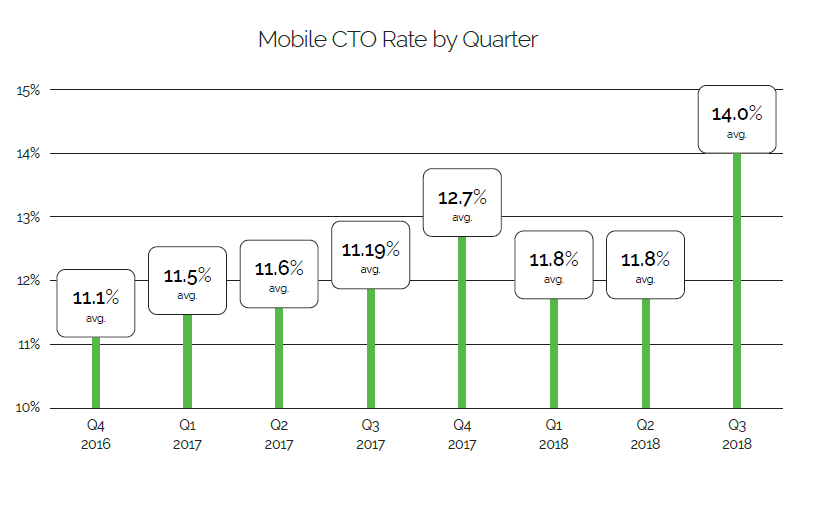The power of email marketing has endured over the years with few major changes. But 2018 produced important email developments that affect online retailers. I’ll address those developments in this post.
Mobile Engagement
While open rates on mobile devices have plateaued over the last two years, mobile click-through rates increased in 2018. Recipients are more comfortable performing complex web interactions entirely on their phones. Moreover, marketers are getting better at designing emails and web experiences that are actionable on mobile from start to finish.
Desktop computers still account for most clicks for most brands. In general, however, consumers still check email on their phone and then go to their desktop to perform in-depth actions, such as purchasing a product.

Mobile click-through rates on email messages increased in Q3 2018 to 14.0 percent. This compares to 11.19 percent for Q3 2017. Source: Yes Marketing.
Gmail
Gmail is easily the most popular email provider in 2018.
Recently Gmail announced that it had reached 1.5 billion users. Roughly one-third of all email addresses will have a Gmail.com domain. Thus it’s imperative for marketers to monitor changes that Gmail makes to its platform.
Roughly five years ago, Gmail revolutionized email marketing by creating the Promotions tab, which automatically filtered marketing messages into a separate folder, away from the inbox. This severely impacted the revenue and traffic for many ecommerce email programs.
More recently, Gmail updated the Promotions tab to give more prominent placement to companies that provide value to their email subscribers. Additionally, Gmail now uses machine learning to group like messages into sub-categories, such as “Top Deals,” and to highlight specifics from the email, such as the offer and the expiration date.
Applying structured data to email code can assist Gmail in identifying the key components of a message. Litmus offers a JSON generator tool that helps marketers create image previews, deal badges, and Gmail annotations.
Also, Gmail frequently changes its algorithms to understand if an email message is cleared for the Promotions tab. Recipient engagement is the main factor.

Gmail has started to reward certain companies with prominent placement in the Promotions tab. In this example, Nesti Home Goods and Pickup Taxi App receive top placement.
Event Themes
One option to increase open and click rates is to reference an upcoming holiday or event. Many brands used this approach in 2018. The top-performing holiday-themed emails for the first three quarters in 2018, according to Yes Marketing, are as follows.

The top-performing holiday themes for 2018 included Groundhog Day in Q1 with a 19.8 conversion rate. In Q2, Earth Day was top with a 4.3 percent conversion rate. In Q3, emails with National Dog Day themes had an 18.6 percent conversion, the highest for that quarter. Source: Yes Marketing.
Inbox More Difficult
Spam filtering at major ISPs has become increasingly rigorous. It can hurt the deliverability of emails from retailers. Most filtering algorithms rely on interaction from recipients. To help ensure your email reaches the inbox, keep these tips in mind:
- Segment your list by frequent versus non-frequent openers. Adjust the sending frequency and cadence by segments.
- Make sure subject lines are accurate and not misleading.
- Maintain consistent branding in all emails.
- Ensure Can-Spam compliance with every email by including a clear unsubscribe link and physical postal address.
- Avoid spam trigger words in subject lines, such as “Congratulations!” and “Winner.” Also, avoid using all caps.




